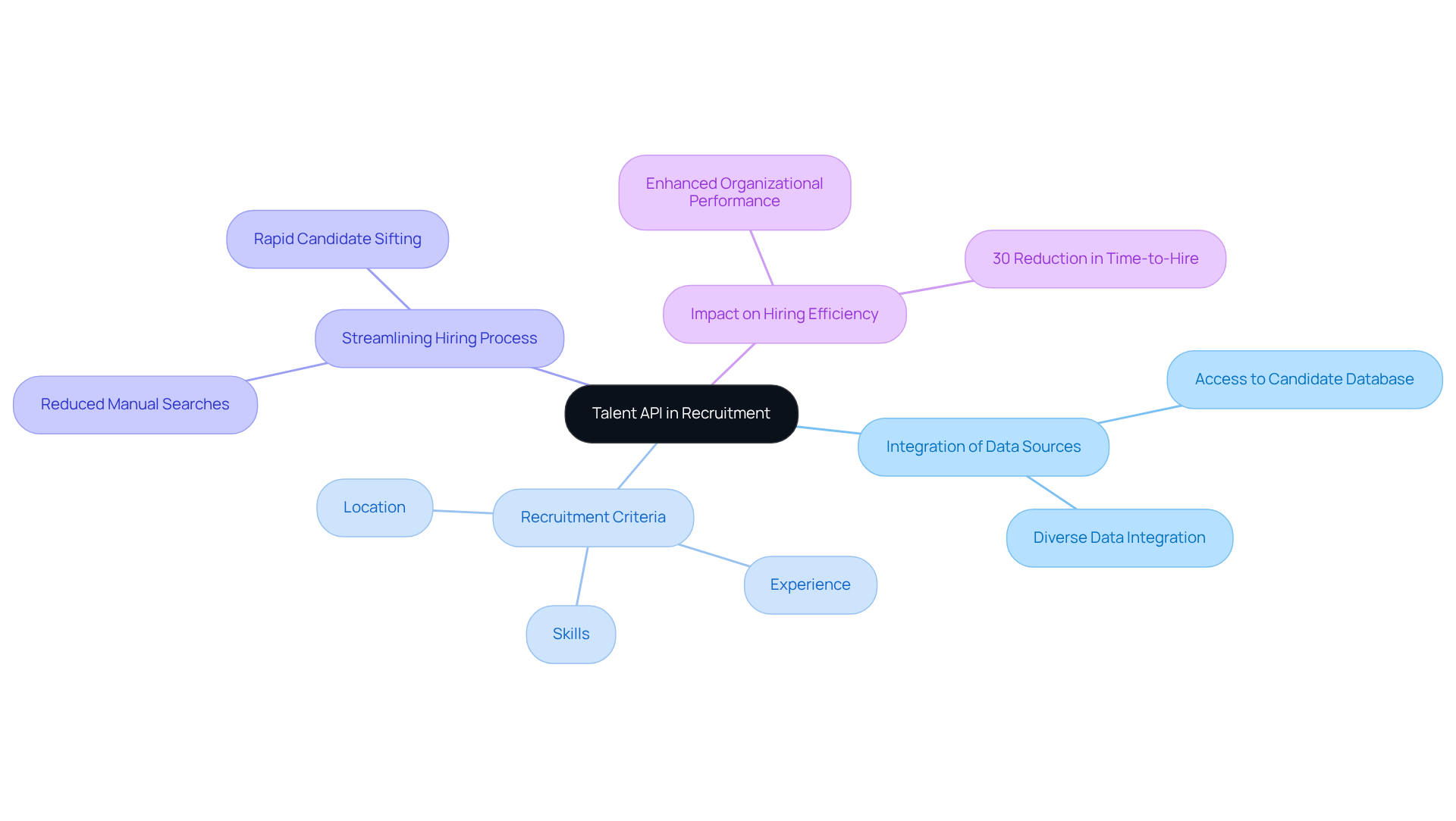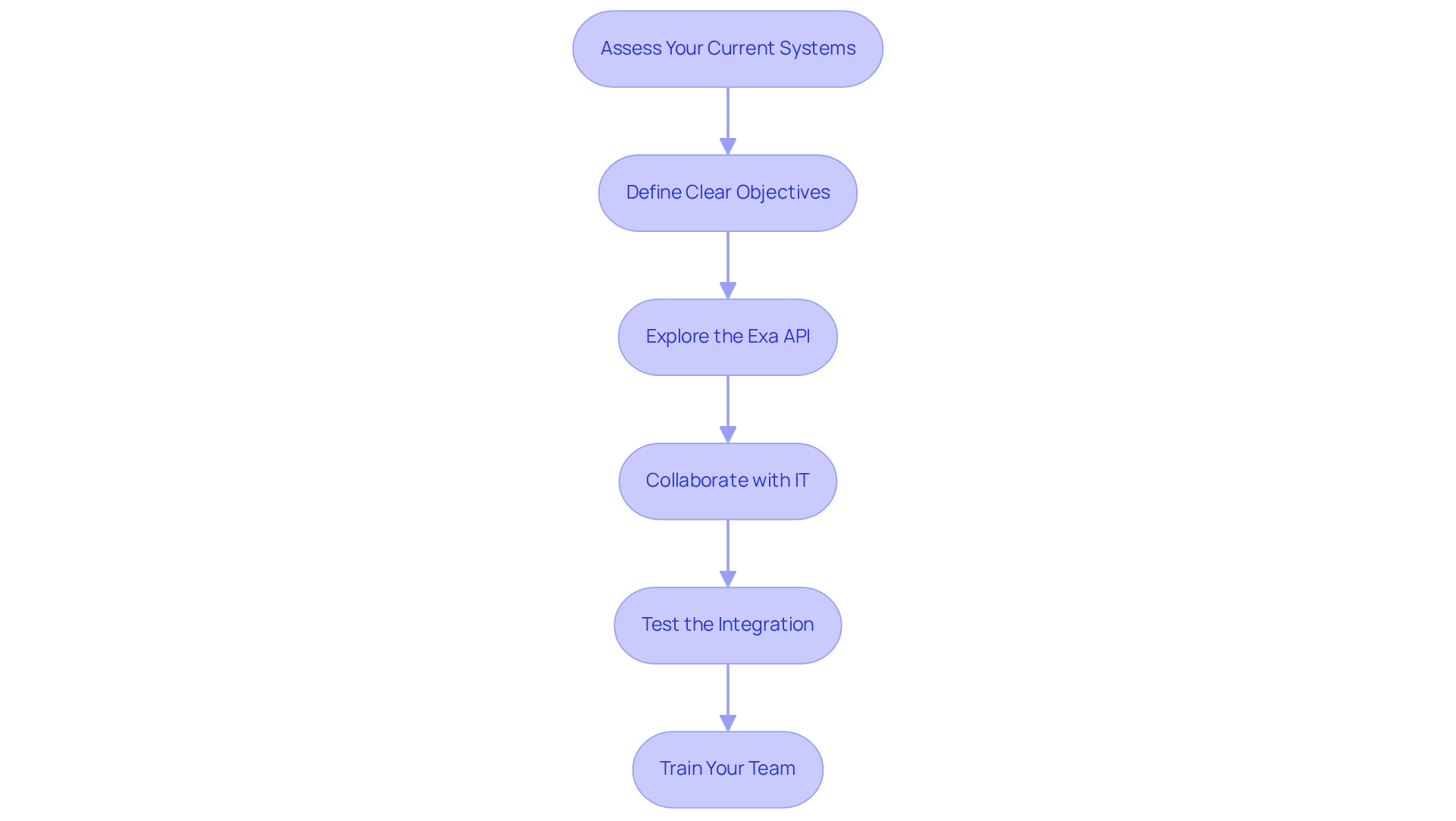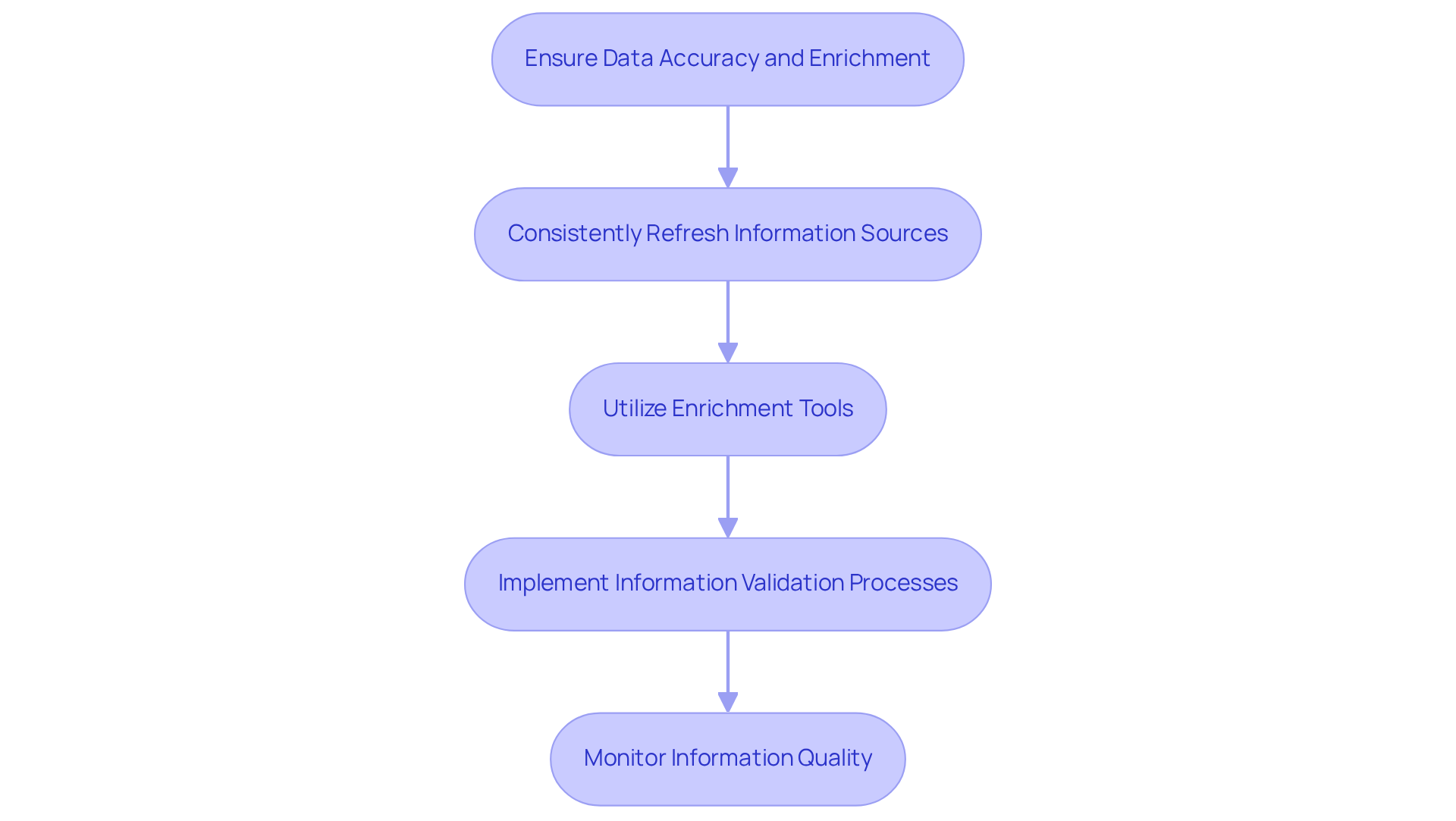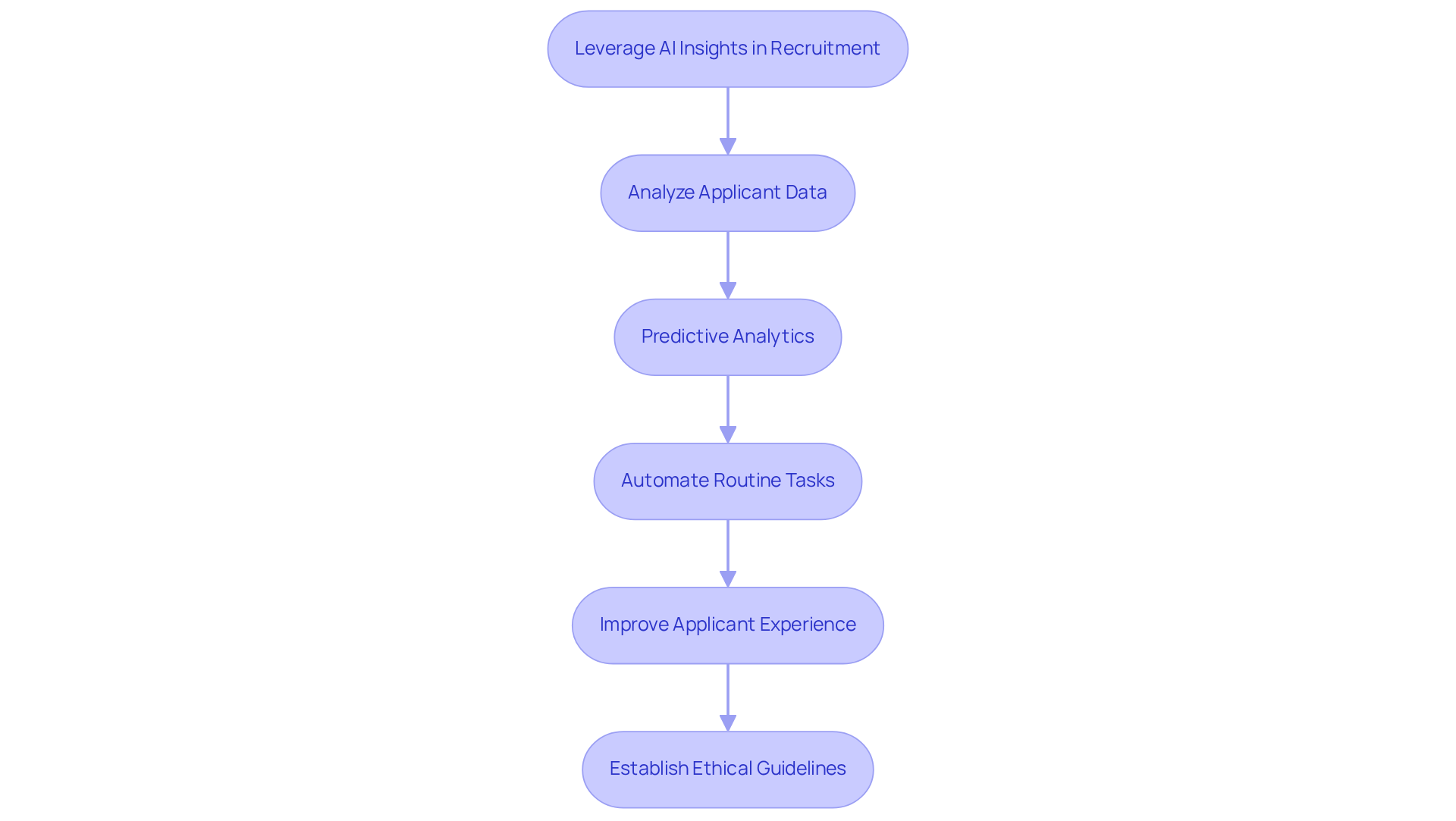Overview
Maximizing recruitment success is paramount for organizations, and the effective use of Talent APIs is a game changer. By integrating these APIs, organizations can:
- Set clear objectives
- Ensure data accuracy
- Leverage AI insights
This strategic approach not only enhances hiring efficiency but also improves the quality of applicants. The result? Better recruitment outcomes that drive organizational success.
Consider the impact: organizations that adopt these best practices can significantly streamline their recruitment processes. By focusing on data-driven insights, they can make informed decisions that lead to a more effective hiring strategy. The integration of Talent APIs offers a pathway to not just fill positions, but to attract top talent that aligns with organizational goals.
In conclusion, the adoption of Talent APIs is essential for any organization looking to elevate its recruitment efforts. By embracing these strategies, companies can transform their hiring processes, ensuring they not only meet but exceed their recruitment objectives. It’s time to take action and leverage the power of technology to enhance your recruitment success.
Introduction
The recruitment landscape is evolving rapidly. Organizations are increasingly turning to technology to enhance their hiring processes. The Talent API emerges as a powerful tool, streamlining candidate searches and expanding access to a diverse pool of applicants. By understanding and implementing best practices for Talent API integration, companies can significantly improve their recruitment efficiency and outcomes. Yet, how can organizations ensure they leverage this technology to its fullest potential while navigating common challenges?
Understand the Talent API and Its Role in Recruitment
The talent API serves as a vital instrument for organizations intent on refining their hiring strategies through the integration of diverse data sources related to potential applicants. By harnessing this API, recruiters can effectively search for candidates based on specific criteria, including skills, experience, and location. This integration not only streamlines the hiring process but also broadens access to a more diverse talent pool.
Companies leveraging a talent API can rapidly sift through thousands of profiles, pinpointing the best matches for open positions and significantly reducing the time spent on manual searches. Notably, statistics indicate that organizations employing Talent APIs experience a remarkable boost in hiring efficiency, with some reporting reductions in time-to-hire by as much as 30%.
Understanding the full capabilities of the talent API is crucial for , which ultimately leads to superior hiring outcomes and enhanced organizational performance.

Implement Best Practices for Talent API Integration
Incorporating the talent API into your hiring processes can significantly enhance both efficiency and the quality of applicants. To ensure a successful integration, follow these best practices:
- Assess Your Current Systems: Evaluate your existing hiring tools and workflows. This assessment will reveal how the capabilities of your current system can be complemented and enhanced by the Talent API, particularly through features like Exa LiveCrawl and Exa Search.
- Define Clear Objectives: Establish specific goals for the API integration, such as reducing time-to-hire or improving applicant quality. Clear objectives will guide the integration process and help measure success.
- Explore the Exa API: Leverage the capabilities of the Exa API to enhance your lead generation and hiring efforts. Understanding Exa's content retrieval and live crawling features can provide .
- Collaborate with IT: Engage your IT department early to facilitate a smooth integration of the API into your existing systems. Their expertise will be crucial in addressing technical challenges and ensuring compatibility.
- Test the Integration: Conduct comprehensive testing of the API before going live. This crucial step will help identify and address any potential issues, ensuring the API operates as intended and meets your hiring needs.
- Train Your Team: Provide thorough training for your hiring team on the API's features and capabilities, including integration with AI tools for enhanced retrieval-augmented generation. Ensuring your team is proficient in using the API will maximize its effectiveness and improve overall hiring performance.
By following these best practices, organizations can achieve a successful integration of the talent API, which will lead to improved recruitment efficiency and a more streamlined hiring process. Statistics indicate that organizations implementing such integrations can experience a 20-40% decrease in time-to-hire, underscoring the potential impact of these strategies.

Ensure Data Accuracy and Enrichment for Optimal Results
To ensure information accuracy and enrichment when utilizing the Talent API, consider the following strategies:
- Consistently Refresh Information Sources: Keeping your information up to date is vital for preserving the integrity of your applicant repository. Regular updates ensure that the information remains relevant and reliable.
- Utilize Enrichment Tools: Leverage advanced tools that enhance applicant profiles with additional information, such as social media links, work history, and skills assessments. This offers a more comprehensive view of candidates, facilitating informed decision-making.
- Implement Information Validation Processes: Establish robust procedures to confirm the accuracy of the information retrieved through the API. This may involve cross-referencing with other databases or employing automated validation tools to ensure reliability.
- Monitor Information Quality: Continuously evaluate the quality of your information to identify discrepancies or outdated details. Regular audits are essential for upholding high information standards.
By emphasizing information precision and enhancement, organizations can greatly improve their hiring results, ensuring they attract and retain the finest talent accessible. Statistics suggest that information-driven hiring can save up to 95% of the time spent on staffing, highlighting the effect of efficient information management on hiring effectiveness.

Leverage AI Insights to Enhance Recruitment Outcomes
To effectively harness AI insights in your recruitment processes, consider the following strategies:
- Analyze Applicant Data: Leverage AI tools to scrutinize historical applicant information, identifying traits of successful hires. This analysis refines your search criteria for applicants, ensuring a more focused approach.
- Predictive Analytics: Implement predictive analytics to anticipate hiring needs based on market trends and organizational growth. This proactive strategy positions your team to stay ahead in the competitive talent acquisition landscape. Companies such as Eightfold employ deep-learning algorithms to pair individuals with positions based on inferred skills, significantly improving hiring accuracy. Furthermore, predictive analytics can pinpoint skills shortages and anticipate future hiring requirements, ensuring your hiring strategy aligns with organizational objectives.
- Automate Routine Tasks: Utilize AI to streamline repetitive tasks such as resume screening and initial applicant outreach. This automation enables your hiring team to focus on strategic initiatives, enhancing overall efficiency. For instance, Chipotle's AI assistant increased application completion rates from 50% to 85%, drastically reducing hiring timelines from 12 days to just 4 days. Additionally, AI can facilitate the onboarding process by automating routine tasks and enhancing the new hire experience.
- Improve Applicant Experience: Utilize to interact with applicants throughout the hiring process, offering prompt updates and responding to questions. This approach not only enhances the candidate experience but also strengthens your employer brand.
- Establish Ethical Guidelines: As you incorporate AI into your hiring processes, establishing ethical guidelines is crucial to ensure fair and unbiased hiring practices. This consideration is essential for maintaining trust and compliance with evolving regulations.
By integrating these AI insights and leveraging the talent API into your recruitment strategy, organizations can significantly enhance their hiring processes, leading to improved outcomes and a more efficient recruitment cycle.

Conclusion
The integration of a Talent API into recruitment processes can fundamentally transform how organizations approach hiring. This innovation allows for a more efficient and effective search for top talent, enabling companies to streamline their hiring strategies and access a broader range of candidates. As a result, organizations can significantly reduce the time spent on traditional recruitment methods.
To maximize the benefits of the Talent API, key strategies such as:
- Assessing current systems
- Defining clear objectives
- Leveraging AI insights
are essential. Ensuring data accuracy through regular updates and validation processes enhances the quality of candidate profiles, ultimately leading to better hiring outcomes. Statistics underscore the impact of these practices; many organizations report substantial reductions in time-to-hire and improved applicant quality.
However, successful implementation of a Talent API transcends mere technology. It requires a rethinking of recruitment strategies to foster a more agile and data-driven hiring process. Organizations must embrace these best practices and leverage AI tools to stay ahead in the competitive talent landscape. By doing so, they ensure they attract and retain the best candidates available.
Frequently Asked Questions
What is the Talent API and its purpose in recruitment?
The Talent API is a tool that helps organizations improve their hiring strategies by integrating various data sources related to potential applicants. It allows recruiters to search for candidates based on specific criteria such as skills, experience, and location.
How does the Talent API improve the hiring process?
The Talent API streamlines the hiring process by enabling recruiters to quickly sift through thousands of candidate profiles, identifying the best matches for open positions, which significantly reduces the time spent on manual searches.
What benefits do companies experience by using a Talent API?
Companies using a Talent API can experience increased hiring efficiency, with some reporting reductions in time-to-hire by as much as 30%. It also broadens access to a more diverse talent pool.
Why is it important to understand the capabilities of the Talent API?
Understanding the full capabilities of the Talent API is crucial for maximizing its impact on hiring initiatives, leading to better hiring outcomes and improved organizational performance.




